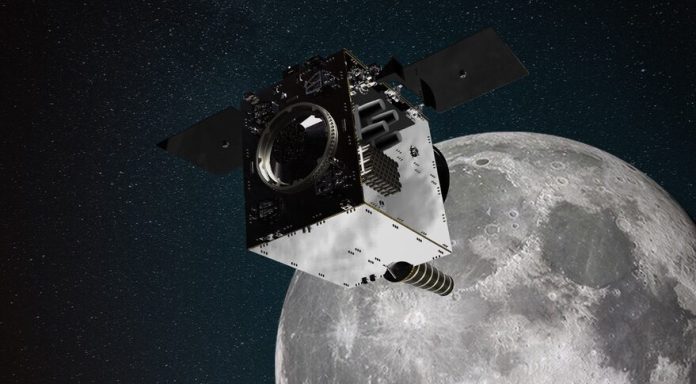The European Space Agency has signed a contract with Surrey Satellite Technology Ltd. (SSTL) to be the anchor customer on a commercial lunar communications satellite that company is developing.
Officials with SSTL and ESA signed the agreement Sept. 15 where ESA will buy communications services and fly payloads on Lunar Pathfinder, a small communications satellite that SSTL plans to launch in 2024 as a demonstration of a future commercial lunar communications network.
Lunar Pathfinder is designed to operate in a “frozen” elliptical orbit that keeps it above the south polar regions of the moon. It will communicate with spacecraft on the lunar surface and in orbit using S-band and UHF frequencies, then relay those communications to Earth on X-band.
“We are delighted to sign up ESA as our anchor customer for communication services from our Lunar Pathfinder mission,” Phil Brownnett, managing director of SSTL, said in a statement. “We have been collaborating with ESA since 2018 to scope our Lunar Pathfinder mission for the commercial market, and we look forward to realizing our ambition to provide cost effective services and navigation data for lunar assets.”
David Parker, director of human and robotic space exploration at ESA, said in an interview that the contract is worth about 20 million euros ($23.5 million) over a minimum of five years. Besides the communications services, ESA is flying a navigation payload to test the ability to use GPS and Galileo signals around the moon and a space weather experiment to monitor radiation. The orbiter will also have a laser retroreflector provided by NASA to support accurate laser ranging of the spacecraft.
Parker said this contract is analogous to NASA’s Commercial Lunar Payload Services (CLPS) program, where NASA buys payload space on commercial lunar landers but is not involved in the development or operation of the lander mission. “This is a situation where ESA is buying the services, buying the payload, but is not responsible for the mission,” he said.
CLPS might end up being a user of Lunar Pathfinder, Parker suggested. “We anticipate that we will have our own needs for the payloads on the spacecraft, but we are also in discussion with NASA on using the data services to potentially support CLPS missions,” he said. That could assist landers in the south polar regions of the moon where direct-to-Earth communications can be difficult.
SSTL was one of two companies, along with Telespazio, that won study contracts from ESA in May for a project called Moonlight that could lead to the development of a satellite constellation around the moon for communications and navigation services. Those studies, examining both technical and financial feasibility, are scheduled to conclude next year.
Parker said the Lunar Pathfinder contract is separate from Moonlight and reflects work between the agency and company that started three years ago. “It doesn’t preclude or predetermine that SSTL would lead a Moonlight constellation at all,” he said. “It’s a proof of concept and test of relevant technologies toward that goal.”
Depending on the results of the Moonlight studies and interest from ESA member states, Parker said the agency would start seeking proposals from industry for the program in about a year, while also working to secure funding for it at the next ESA ministerial meeting in late 2022. While Lunar Pathfinder has low data rates intended to support robotic missions, he noted Moonlight would be designed for future human missions.
– Advertisement –
